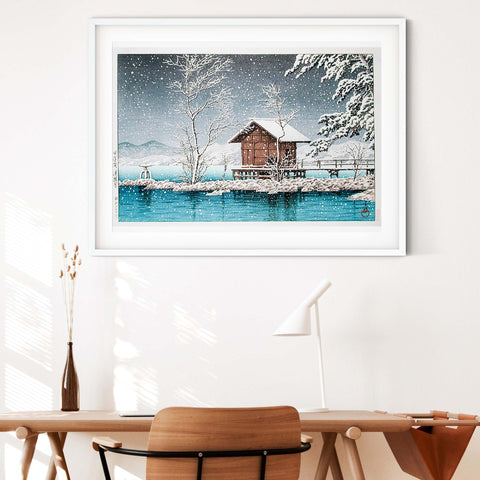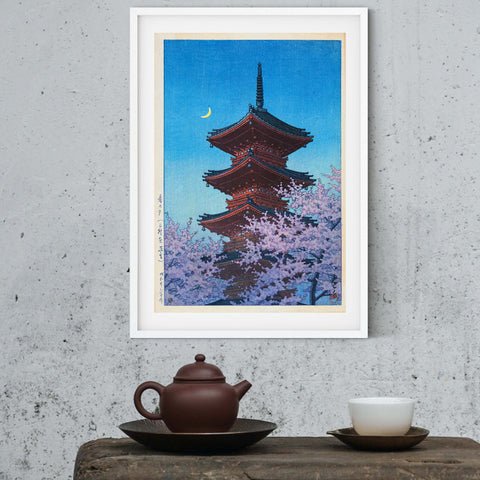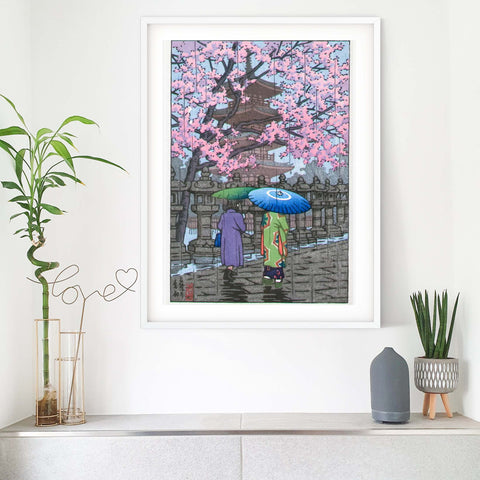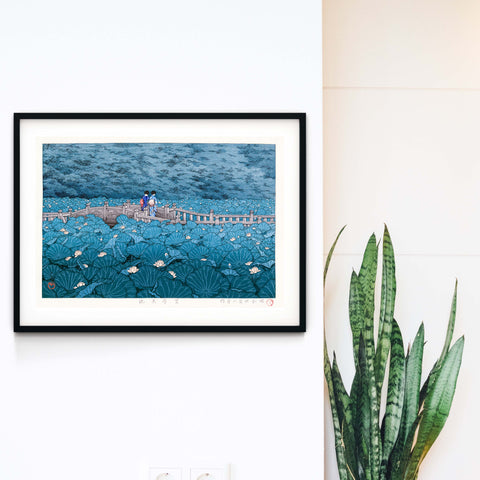A Visionary Artist Amidst Transformation
Kawase Hasui (1883–1957) stands as a monumental figure in the realm of Japanese printmaking.
Part of the shin-hanga (new print) movement in the 1920s, Hasui crafted works that evoke nostalgia and romanticized views of Japan.
A renaissance of sorts, shin-hanga encapsulated traditional woodblock print production techniques, using a team of a publisher, carvers, and skilled printers.

The Western Fascination and Domestic Struggle
Despite Japan's quick embrace of modernisation towards the end of the 19th century, Hasui's traditional lens didn't find immediate favour at home.
It was the Western collectors—Americans and Europeans—who first appreciated the charm and exoticism Hasui's art encapsulated.
They yearned for the 'original' Japan, especially when the island nation was opening its doors to Western influences.
A Deep Connection to Native Landscapes
The colour woodblock print has a storied history in Japan, reaching its height with artists like Utagawa Hiroshige in the 1800s.
But when Japan opened its ports in 1868, this art form saw a decline, only to be rejuvenated in the early 20th century.
It was this modern yet deeply rooted Japan that Hasui represented in his prints.

A Late Bloomer With Lasting Influence
Interestingly, Hasui started as a painter and commercial illustrator.
He pivoted to printmaking in his late 30s, demonstrating a unique skill for transcribing the Japanese landscape into print.
Quietly understated yet resoundingly influential, Hasui's main subjects were iconic locations and hidden gems in Tokyo, Kyoto, and other scenic rural areas.

The Immortalised Japan
Hasui's oeuvre is often noted for what it doesn't show.
His art doesn't capture the catastrophic events that befell Japan during his lifetime, like the Great Kanto Earthquake in 1923 or the Allied bombings of WWII.
His landscapes depict a Japan that seems to resist the tides of change, a serene and idealised vision that continues to captivate viewers to this day.

A Life's Work and Lasting Legacy
Over a career spanning roughly 40 years, Hasui designed approximately 600 prints.
His efforts were officially recognized by the Japanese government in 1952, marking his significant contributions to Japanese culture.
While his home was destroyed twice—first by the earthquake and then by wartime bombings—his art remains a testament to the enduring beauty and tranquillity of Japan.
The Cultural Catalyst
Hasui was more than an artist; he was a catalyst who perpetuated Japanese culture through his art. He engaged with a traditional art form while offering it new life, turning the cultural narrative of Japan inwards even as the country faced increasing Westernization.
Through his art, he provided a medium for the world to experience Japan's traditional beauty, making it accessible and eternal.
A Spiritual Sanctuary in Print
Even today, Hasui's work is a refuge for those who seek the untouched beauty of Japan—a place that lives in the imagination but finds form in his art.
The continued appeal of his prints affirms that while the world around us may change, the serene landscapes captured by Hasui remain timeless, offering a peaceful haven in an ever-changing world.
If you're captivated by the tranquil yet striking landscapes of Kawase Hasui, you're in luck.Lelloliving offers a wide selection of framed Kawase Hasui and Japanese Ukiyo-e prints, allowing you to bring a slice of this timeless beauty right into your living space


